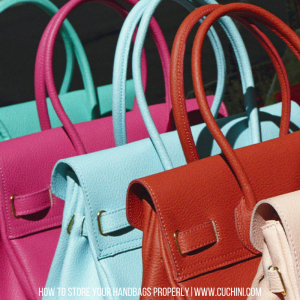 Your purses are like your babies—your non-bodily-fluid-expelling, non-wailing, and non-screaming-at-3 a.m. infants. They may not be able to thrash around and throw a tantrum when you aren’t giving them what they want, but they will make their disappointment known in a subtler yet equally frustrating way. Every bag owner knows the heartbreak of seeing an originally pristine white tote bag don a ghastly new stain that looks undeniably similar to the colored bag it regularly sits beside in your closet. A rookie mistake, some experts may say—but don’t worry, we don’t get to my-bag-looks-brand-new-after-ten-uses level without first passing this-used-to-be-cream-not-brown first.
Your purses are like your babies—your non-bodily-fluid-expelling, non-wailing, and non-screaming-at-3 a.m. infants. They may not be able to thrash around and throw a tantrum when you aren’t giving them what they want, but they will make their disappointment known in a subtler yet equally frustrating way. Every bag owner knows the heartbreak of seeing an originally pristine white tote bag don a ghastly new stain that looks undeniably similar to the colored bag it regularly sits beside in your closet. A rookie mistake, some experts may say—but don’t worry, we don’t get to my-bag-looks-brand-new-after-ten-uses level without first passing this-used-to-be-cream-not-brown first.
No matter what stage of bag collecting you’re in—be it a newbie, a veteran, or just someone who knows the value of taking care of their belongings—you should always brush up on your storage knowledge to ensure that the next time you step out in a fashion forward outfit, your prized handbag can act as the finishing touch to your masterpiece of a look, and not your grand faux pas.
Stuff it
No matter how unique the fabric or the design, how a certain article of clothing fits on your body completely makes or breaks the success factor of an outfit. And just like you, your purse also possesses its own skeleton that needs to sit and stand right in order for its full beauty to be appreciated. Once it loses its proper structure, you lose 90% of its sophistication and aesthetical value, and more importantly, most your money’s worth. When storing, always make sure to stuff the interior of your handbag with bubble wrap, acid-free tissue paper, or a puffy shape saver to keep the shape intact. Avoid using crumpled scratch papers or newspapers to fill up the space, as the ink may rub off on the material inside and create stains.
Yes to storing, no to shoving
Off-season bags often find themselves in the deepest depths of your closet, but it shouldn’t be that way. Give them a temporary home during their hiatus instead of shoving them in the nooks and crannies of your wardrobe, since this distorts the shape for an extended period of time. The last thing you need after months of waiting to use that Prada Cahier bag is to fish it out bent and misshapen, too disfigured to use when you actually need it. Find spacious and easily accessible containers that you can slide out in the right time. Label these boxes to help you remember their contents, either through printouts of pictures or a simple handwritten note reminding you of their brand and model.
Say goodbye to hooks
Although it may seem like a great space saver, you risk stretching out the handles of your handbags when you allow them to hang on hooks. It’s no secret that straps are generally smaller and thinner than the actual body of the bag, so allowing them to sag under the pull of their own weight will create loose and misshapen handles. Instead, opt to use fabric dust bags with drawstrings or mesh bag carriers to hold up your purses. Not only does this retain the integrity of your carrier, but it also doubles as a protective layer too.
Install shelf cubbies or storage cubes
In line with retaining the shape of your purses, keeping them standing upright in a linear position is the best way to keep them well-maintained. Dividing and conquering different shapes and sizes by using cube containers or shelf dividers within the rows also allows you to efficiently organize your bags in a space-efficient manner. A word of warning: Don’t forget to give your purses an ample amount of ventilation to keep the quality of their fabric from diminishing. Genuine animal material will require a good amount of “breathing room” to avoid attracting mildew.

Double stuffing no-nos
Before you pat yourself on the back for hitting two birds with one stone after placing that tiny saddle bag inside your Kate Spade canvas tote, hold that praise—double stuffing stretches the interior of your larger bag and mixes different colors and fabrics together when they should be properly separated. You’re losing more than you’re gaining when you restrict your smaller purses to the confines of another bag’s structure, and more so when your larger bags’ inner linings are pushed by unfamiliar edges.
Cover up
Most bags come with complementary dust bags, and for good reason—your purses aren’t meant to lie out in the open, even in the most sanitary wardrobe. To ensure that they stay in their original mint condition, cover any hardware metals (zippers, buttons, etc.) with plastic to avoid stains forming over time on the fabric they lie on.
Store leather in low light
Especially with the genuine kind, it’s important that you store your leather bags in a no-light or low-light environment, as direct sunlight will irreversibly decrease its color quality. Go the extra mile—find a storage area for your leather goods with a controlled 50-50 humidity value to make sure that you’re giving it just enough moisture to avoid rotting, but not too much to foster molding.
 Did you enjoy this article?
Did you enjoy this article?






